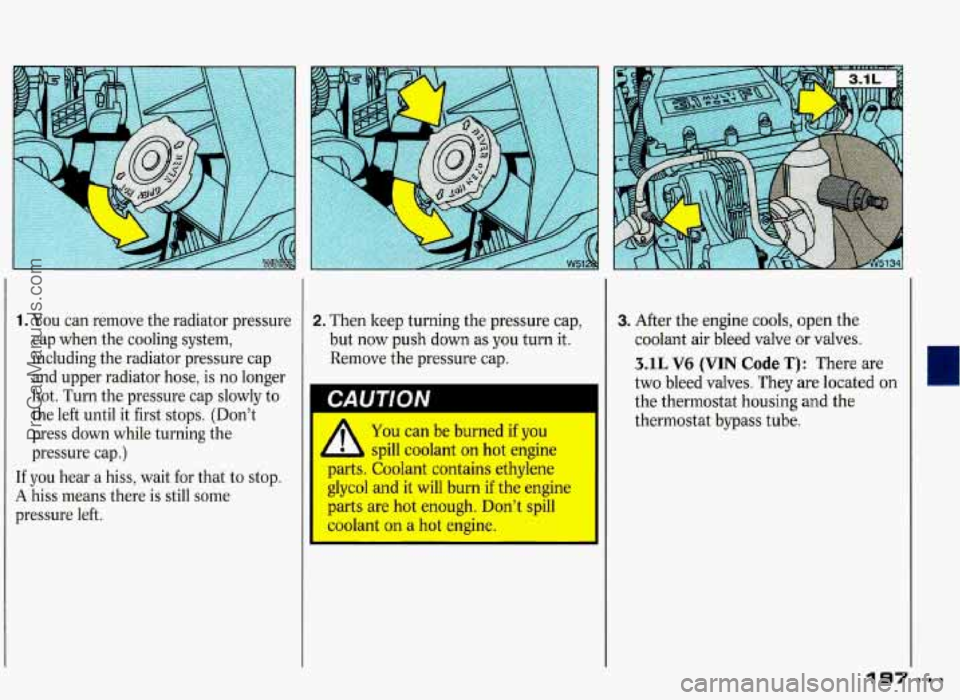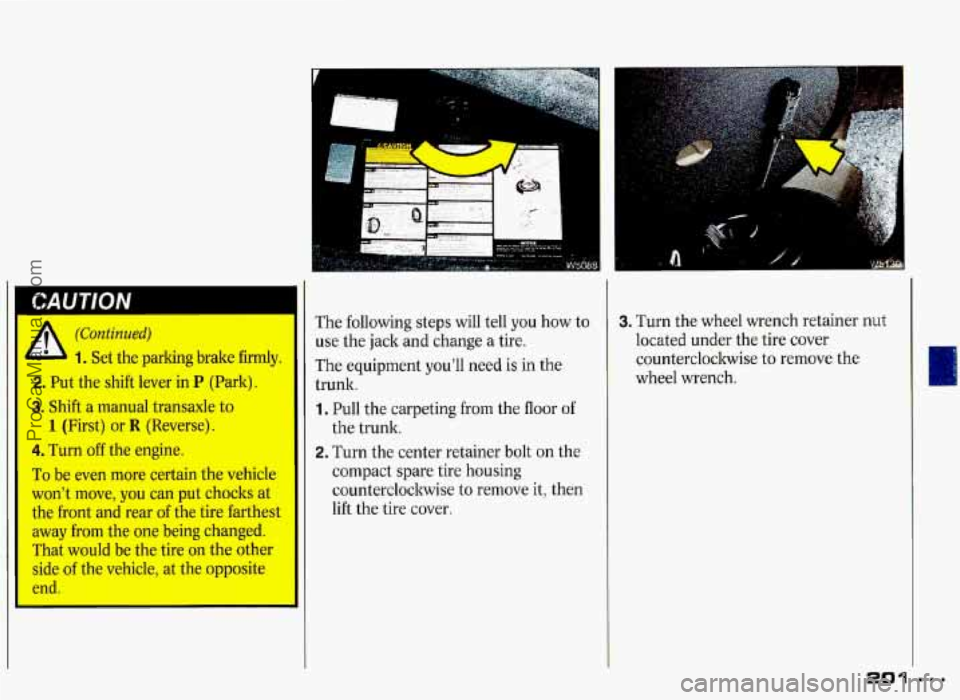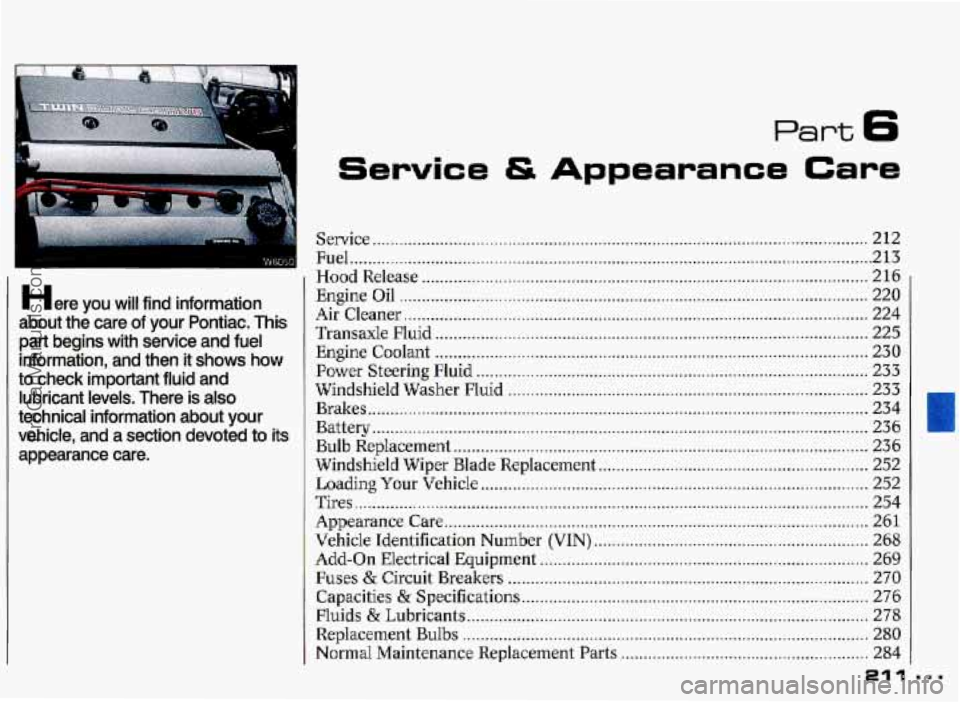1993 PONTIAC GRAND-PRIX engine
[x] Cancel search: enginePage 198 of 338

1. You can remove the radiator pressure
cap when the cooling system,
including the radiator pressure cap
and upper radiator hose, is
no longer
hot. Turn the pressure cap slowly to
the left until it first stops. (Don’t
press down while turning the
pressure cap.)
If you hear a hiss, wait for that to stop.
A hiss means there is still some
pressure left.
2. Then keep turning the pressure cap,
but now push down as you turn it.
Remove
the pressure cap.
I CAUTION
I A You can be burned if you
spill
coolant on hot engine
pa La. Coolant contains ethylene
glycol and it will burn if the engine
parts
are hot enough. Don’t spill
coolant on a hot engine.
3. After the engine cools, open the
coolant air bleed valve or valves.
3.1L V6 (VIN Code T): There are
two bleed valves. They
are located on
the thermostat housing and the
thermostat bypass tube.
ProCarManuals.com
Page 199 of 338

Problems on the Road
I I
~
I..
€ngh Overheating (cow.)
3.4L V6 (VIN Code X): There are
two bleed valves. They are located on
the thermostat housing and the
heater inlet pipe.
1 918
4. Fill the radiator with the proper mix,
up to the base of the filler neck.
If you see a stream of coolant coming
from an air bleed valve, close the valve.
Otherwise, close the valve(s) after the
radiator is filled.
5. Rinse or wipe any spilled coolant
from the engine compartment.
6. Then fill the coolant recovery tank to
the
COLD mark.
ProCarManuals.com
Page 200 of 338

7. Put the cap back on the coolant 8. Start the engine and let it run until
recovery tank, but leave the radiator
you can feel the upper radiator hose
pressure cap off. getting hot.
Watch out for the engine
fans.
9. By this time the coolant level inside
the radiator filler neck
may be lower.
If the level is lower, add more of the
proper
mix through the filler neck
until the level reaches the base of the
filler neck.
10. Then replace the pressure cap. Be
sure the arrows
on the pressure cap ~
line up like this
11. Check the coolant recovery tank.
The coolant level should be at
HOT
when the engine is hot and at
COLD when the engine is cold.
ISS...
ProCarManuals.com
Page 202 of 338

I I
CAUTION
(Continued)
1. Set the parking brake firmly.
2. Put the shift lever in P (Park)
3. Shift a manual transaxle to
1 (First) or R (Reverse).
4. Turn off the engine.
To be even more certain the vehicle
won’t move, you can put chocks at
the front and rear of the tire farthest
away from the one being changed.
That would be the tire on the other
side of the vehicle, at the opposite
end.
I
P====
The following steps will tell you how to
use the jack and change
a tire.
The equipment you’ll need is
in the
trunk.
1. Pull the carpeting from the floor of
the trunk.
2. Turn the center retainer bolt on the
compact spare tire housing
countercloclwise
to remove it, then
lift the tire cover.
3. Turn the wheel wrench retainer nut
located under the tire cover
counterclockwise to remove the
wheel wrench.
201
U
8..
ProCarManuals.com
Page 209 of 338

Problems on the Road
if You’re Stuck: In Sand, Mud, Ice
~ or Snow
What you don’t want to do when your
vehicle is stuck
is to spin your wheels.
The method known as “rocking” can
help
you get out when you’re stuck, but
you must use caution.
CAUTION
~ Spinning your wheels can destroy
parts
of your vehicle as well as the
tires.
If you spin the wheels too
fast while shifting your transaxle
back and forth, you can destroy
your transaxle.
If
you let your tires spin at
b high speed, they can explode
llyu you or others could be injured.
And, the transaxle or other parts of
the vehicle can overheat. That
could cause an engine compartment
fire
or other damage. When you’re
stuck, spin the wheels as little
as
possible. Don’t spin the wheels
above
35 mph (56 h/h) as shown
on the speedometer.
I
Rocking Your Vehicle to Get it Out:
First, turn your steering wheel left and
right. That will clear the area around
your front wheels. Then shift back and
forth between
R (Reverse) and a
forward gear (or with a manual
transaxle, between First or Second gear
and Reverse), spinning the wheels as
little as possible. Release the accelerator
pedal while you shift, and press lightly
on the accelerator pedal when the
transaxle is in gear.
If that doesn’t get
you out after a few tries, you may need
to be towed out.
If you do need to be towed out, see the
Index under Towing Your Pontiac.
ProCarManuals.com
Page 212 of 338

Part 6
Here you will find information
about the care
of your Pontiac . This
part begins with service
and fuel
information. and then it
shows how
to check important fluid and lubricant levels
. There is also
technical information about your
vehicle. and a section devoted
to its
appearance care
.
81 1
Service & Appearance Care
Service ........................................................................\
...................................... 212
Fuel ........................................................................\
............................................ 213
Hood Release ........................................................................\
............................ 216
Engine Oil
........................................................................\
................................ 220
Air Cleaner ........................................................................\
............................... 224
Transaxle
Fluid ........................................................................\
........................ 225
Engine Coolant ........................................................................\
........................ 230
Power Steering Fluid ........................................................................\
............... 233
Windshield Washer
Fluid ........................................................................\
........ 233
Brakes
.......... .......................... ........................................................................\
... 234
Battery
........................................................................\
........................ .... .......... 236
Bulb Replacement ........................................................................\
.................... 236
Loading
Your Vehicle ........................................................................\
.............. 252
Vehicle Identification Number (VIN) ............................................................. 268
Capacities
& Specifications ........................................................................\
..... 276
Replacement
Bulbs ................................................................... .......- ............... 280
Windshield Wiper
Blade Replacement ............................................................ 252
Tires ........................................................................\
.......................................... 254
Appearance Care ........................................................................\
...................... 261
Add-on Electrical Equipment ........................................................................\
. 269
Fuses & Circuit Breakers ........................................................................\
........ 270
Fluids
& Lubricants ........................................................................\
................. 278
Normal Maintenance Replacement Parts ....................................................... 284
ProCarManuals.com
Page 214 of 338

Fuel
Use regular unleaded gasoline rated at
87 octane or higher. It should meet
specifications ASTM D4814 in the U.S.
and CGSB
3.5-92 in Canada. These
fuels should have the proper additives,
so you should not have to add anything
to the fuel.
In the
U.S. and Canada, it’s easy to be
sure you get the right kind of gasoline
(unleaded). You’ll see “UNLEADED”
right on the pump. And only unleaded
nozzles will fit into your vehicle’s filler
neck.
Be sure the posted octane is at least 87.
If the octane is less than 87, you may
get a heavy knocking noise when you
drive. If
it’s bad enough, it can damage your
engine.
If you’re using fuel rated at 87 octane or
higher and you still hear heavy
knocking, your engine needs service.
But don’t worry
if you hear a little
pinging noise when you’re accelerating
or driving up a hill. That’s normal, and
you don’t have to buy a higher octane
fuel
to get rid of pinging. It’s the heavy,
constant knock that means you have a
problem.
Fuel Capacity:
16.5 U.S. Gallons (62 L) . Use unleaded
fuel only.
What about gasoline with blending
materials that contain oxygen, such as
MTBE
or alcohol?
MTBE is “methyl tertiary-butyl
ether.” Fuel that is no more than
15%
MTBE is fine for your vehicle.
Ethanol is ethyl or grain alcohol.
Properly-blended fuel that
is no more
than
10% ethanol is fine for your
vehicle.
Methanol is methyl or wood alcohol.
Fuel that is more than
5%
methanol is bad for your vehicl
Don’t use
it. It can corrode me
parts in your fuel system and a
damage plastic and rubber parts.
That damage wouldn’t be covered
under your warranty. And ev
5% or less, there must be
“cosolvents” and corrosion
ProCarManuals.com
Page 215 of 338

...
Service 4S Appearance Care
Gasolines for Cleaner Air
Your use of gasoline with detergent
additives will help prevent deposits
from forming in your engine and fuel
system. That helps keep your engine in
tune and your emission control system
working properly. It’s good for your
vehicle, and you’ll be doing your part
for cleaner air.
Many gasolines are now blended with
materials called oxygenates. General
Motors recommends that you use
gasolines with these blending materials,
such
as MTBE and ethanol. By doing
so, you can help clean the air, especially
in those parts of the country that have
high carbon monoxide levels.
214
In addition, some gasoline suppliers are
now producing reformulated gasolines.
These gasolines are specially designed
to reduce vehicle emissions. General
Motors recommends that
you use
reformulated gasoline. By doing
so, you
can help clean the air, especially in
those parts
of the country that have
high ozone levels.
You should ask your service station
operators
if their gasolines contain
detergents and oxygenates, and
if they
have been reformulated to reduce
vehicle emissions.
Fuels in Foreign Countries
If you plan on driving in another
country outside the
U.S. or Canada,
unleaded fuel may be hard to find.
Do
not use leaded gasoline. If you use even
one tankful, your emission controls
won’t work well or at all. With
continuous use, spark plugs can get
fouled, the exhaust system can corrode,
and your engine oil can deteriorate
quickly. Your vehicle’s oxygen sensor
will be damaged. All of that means
costly repairs that wouldn’t be covered
by your warranty.
ProCarManuals.com